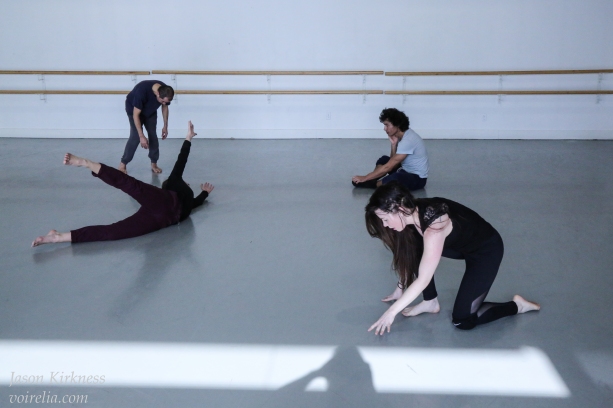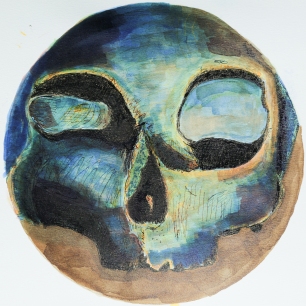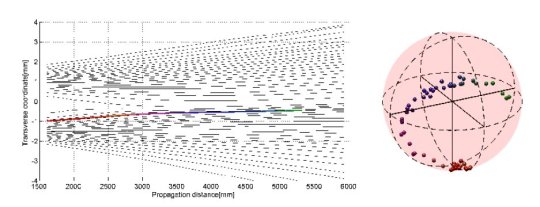A June 26, 2018 HR MacMillan Space Centre (HRMSC) press release, received via email, announces an upcoming art/sci event,
This July the H.R. MacMillan Space Centre and Voirelia: Dance, Psychology and Philosophy Hub will be co-hosting Quantum Inkblot, an interactive evening exploring quantum physics through the lenses of physics and psychology, art, and astronomy. The evening will incorporate talks by a physicist and a psychologist, visual artwork, and original contemporary dance performances.
The talks and artistic works will explore some of the questions about how psychology and physics can mirror, inspire, and influence one another. We will touch on topics related to relativity, uncertainty, and predictability of this world.
A dialogue-style talk will be led by physicist Dr. Jaymie Matthews and psychologist Dr. Alina Sotskova exploring the intersections of quantum physics and psychology. Dr. Matthews will be discussing the concept of wave-particle duality and the way it takes the assumption that one thing cannot be in two places at once and turns it on its head.
Dr. Sotskova will be talking about the dissonance in predicting the behaviour of groups vs. predicting the behaviour of individuals, giving pause to reflect on the existence of order at a macro level and chaos at the micro level.
The evening will also feature three original contemporary dance performances and a visual art and music presentation that were all inspired by themes in psychology and the intersection with physics.
There will be time between performances to enjoy a drink, take part in interactive art activities, watch physics demonstrations, and chat with physicists, artists, and psychologists. The evening will end with a question and answer period with all of the performers and speakers.
Here are logistics and additional details,
Quantum Inkblot will take place at the H.R. MacMillan Space Centre Thursday, July 12th.
This is a 19+ event.
6:30pm doors open, 7:00pm show starts in the Planetarium Star Theatre
$25 for tickets
Tickets available online through Eventbrite,[clicking on this link will give you a map to the location] in person, or by phone at 604.738.7827.
Find the Quantum Inkblot event on Facebook for sneak peeks at the art work being created, learn more about the process of collaboration between artists and scientists, and more!
The H.R. MacMillan Space Centre is a non-profit community resource that brings the wonders of space to Earth, while providing a personal sense of ongoing discovery. Through innovative programming, exhibits and activities, our goal is to inspire sustained interest in the fields of Earth science, space science and astronomy from a Canadian perspective.
Voirelia is a Vancouver-based Dance, Psychology, and Philosophy Hub. Its main purpose is to create original dance and art works inspired by ideas in psychology and philosophy. Voirelia also organizes talks, workshops, and events relevant to the intersection between dance, psychology, & philosophy, such as talks on philosophy of science. Our aim is “movement with meaning.”
BC Psychological Association has provided support for this event and BCPA representatives will be available to chat with the guests.
Voirelia provides a few more information and pictures on its Upcoming Projects webpage,
There will be several dance works presented during Quantum Inkblot. Here are the latest shots from one of the rehearsals, with physicists Dr. Jaymie Matthews and Dr. Ewan Hill joining us for a transdisciplinary open-rehearsal style session.
Photographs: Jason Kirkness. Dancers: Sophie Brassard, Michael Demski. Rehearsal direction/choreography: Alina Sotskova. [Not all the images have been included in this excerpt.]
We wanted to document our artistic and creative process as we put together this unique event. Below you will see examples of original art works and how artistic creation progresses. In the dance photographs below (by Jason Kirkness), we had a brainstorming session that included people with backgrounds in physics, psychology, dance, and theater. We spent about an hour talking about concepts from quantum physics that people often find “weird” – such as the concepts of waves, particles, wave-particle duality, and the uncertainty principle. We touched on how quantum physics influences our perception of science, the world, and ourselves. We discussed topics of identity and searching for meaning and why the quantum world is so different from what we see with our senses. Then we took our brainstorming to the dance studio. Here, using prompts suggested by physicists and her own knowledge as a psychologist and dancer, Alina Sotskova facilitated improvisational movement exploration. This yielded a great deal [sic] of ideas about parallels between physics and psychology, and we will use these ideas a spring board as we begin to develop specific dance works for the event. You can also check out short videos of the improvisational movement research session on our Facebook page, in the Videos section. [Not all the images have been included in this excerpt.]
The team who was part of the brainstorming session […] included: Andrew Elias (Graduate Student working in the field of quantum physics, UBC); Jason Kirkness (Co-lead for the Quantum Inkblot Event and; background: physics and computer science); Alina Sotskova (Co-lead for the Quantum Inkblot Event and; background: psychology and dance). Our dancers were: Angelo Moroni, Michael Demski, Carolyn Schmidt, Alejandra Miranda Caballero, Alina Sotskova.
The images below are samples of original art works by Andrew Short, one of Voirelia’s Core Consultants. Inspired by topics in quantum physics, psychology, and cosmology, Andrew is working on preparing a very special presentation especially for Quantum Inkblot. [There are more images at Voirelia.]
Interestingly, this does not seem to be a ‘sister’ event to Toronto’s ‘Out Of This World; Art inspired by all things astronomical’ exhibition and talks being held July 4 – 22, 2018 in honour of the Royal Astronomical Society of Canada’s (RASC) sesquicentennial (150th anniversary). There’s more about Toronto’s astronomical art/science event in my July 2, 2018 posting.










